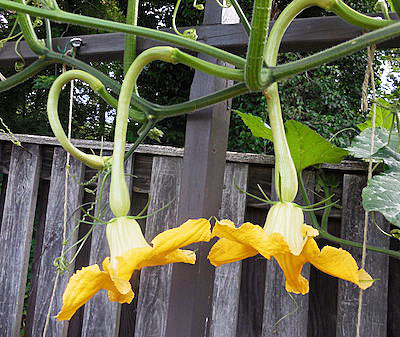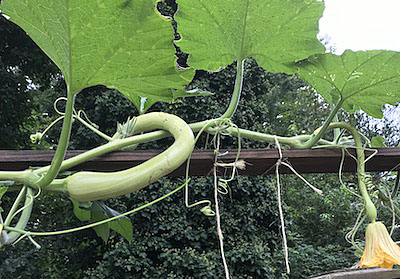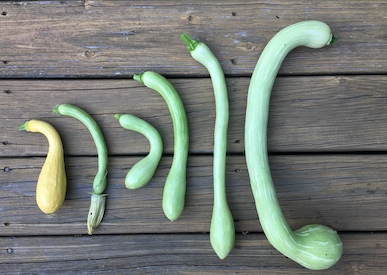International Gardener
A Summer Squash That’s Different and Worth Trying
By Tony Makara, Fairfax Master Gardener
 Many gardeners, whether new or experienced, appreciate the fun of growing varieties of vegetable plants that are relatively uncommon. Among these could be purple sweet peppers, yard-long string beans, or scarlet-colored kale. Fun stuff! Not surprising, many such great vegetables never find their way to a grocery store bin, and we miss out on what would otherwise be a healthy, nutritious and pleasurable taste treat. In that spirit of discovery, I happened upon an heirloom summer squash that has since become a keeper.
Many gardeners, whether new or experienced, appreciate the fun of growing varieties of vegetable plants that are relatively uncommon. Among these could be purple sweet peppers, yard-long string beans, or scarlet-colored kale. Fun stuff! Not surprising, many such great vegetables never find their way to a grocery store bin, and we miss out on what would otherwise be a healthy, nutritious and pleasurable taste treat. In that spirit of discovery, I happened upon an heirloom summer squash that has since become a keeper.
Known as “Trombetta di Albenga,” or Tromboncino Rampicante, this is an 18-inch to 24-inch elongated sausage-shaped squash whose name translates as “little trumpet from Albenga.” Albenga is a coastal town on the Italian Riviera, not far from Genoa, Italy. How can a title such as that not make one smile?
It is a cultivar of Cucurbita moschata. Lime-green in color, this fruit has a long neck that is dense and seed-free, and a bulb-like area at the bottom that contains all the seeds. It has a nutty, artichoke-like taste and not watery at all in texture. Besides its unique shape, the second distinguishing feature is that this plant is a vining climber as opposed to the bush-type growth found in more common summer squash cousins: yellow, pattypan or zucchini. How far can it wander? Think Jack and the Beanstalk.

Female Flowers
Owing to its denseness and absence of seeds in the edible neck, it does very well when used in typical summertime squash recipes. It can be steamed, grilled, sautéed, baked, roasted or salami-sliced (cooked or served over a salad) or pureed as a creamy soup that can be eaten hot or cold, or frozen for later. Given its unique long and narrow shape, it goes through a spiralizer very well. This device cuts vegetables and fruit into long ribbons resembling noodles or spaghetti. Toward the end of the growing season, it can also be left to mature on the vine, where it can grow up to 36 inches. Once it turns beige, it becomes a winter squash, similar in taste to butternut.
The Trombetta is remarkably pest and disease-resistant. In other summer squash, the Squash Vine Borer larvae bores into a plant’s hollow stem and feeds from the center, often causing the plant to be lost. However, the Trombetta has a dense, thick stem with no place for the larvae to penetrate. It is also highly resistant to Downy Mildew. This is great news for gardeners.

Climbing vine on trellis
Although I have a relatively large amount of space in my yard where I could let it ramble, I prefer to train my Trombetta plant to climb my wooden fence. Once the vine reaches the top of the fence (or what I like to call the “cruising altitude”), I then train it to continue its growth along the fence top. I loosely tie some jute or garden twine around the vine stem and the fence slats every 3 to 4 feet to keep it guided in the direction I want it to grow. This also helps to ensure that the weight of the growing fruit does not pull down the vine from the fence. Alternatively, it can grow up a deck post, across the railing, and down again, or throughout an arbor. Just keep your door closed to keep it from wandering inside your house. Its large heart-shaped leaves and hanging fruit are a visual appeal, and its flowers are great pollinators. You will smile often when looking at this amazing plant.

Various stages next to yellow crookneck squash
If it could talk to the gardener, this plant would probably say: “Thank you for planting me and allowing me into your garden. I’ll strive to be trouble free, give you healthy nourishment, present you a visual delight and I’ll continue to reward you beyond your expectations.”
See? You’re smiling already!
Resources
• Tromboncino Squash, Home and Garden Information Center, Clemson University, August 1, 2019
• Trombetta Squash – Summer, Vegetable Varieties, Cornell University
• Hanging Squash, North State Garden News, University of California, Aug 26, 2014
• Vertical Vegetable Gardening, Trinity County Cooperative Extension, University of California
Agriculture and Natural Resources